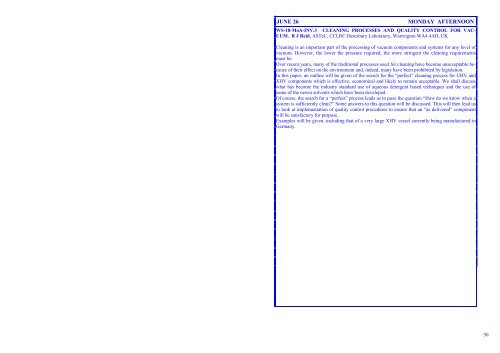Wüest M. 51 Wykes M. 82 Yamaguchi M. 17 Ybarra G. 129 Yubero F ...
Wüest M. 51 Wykes M. 82 Yamaguchi M. 17 Ybarra G. 129 Yubero F ...
Wüest M. 51 Wykes M. 82 Yamaguchi M. 17 Ybarra G. 129 Yubero F ...
Create successful ePaper yourself
Turn your PDF publications into a flip-book with our unique Google optimized e-Paper software.
JUNE 26 MONDAY AFTERNOON<br />
WS-18-MoA-INV.3 CLEANING PROCESSES AND QUALITY CONTROL FOR VAC-<br />
UUM. R J Reid, ASTeC, CCLRC Daresbury Laboratory, Warrington WA4 4AD, UK<br />
Cleaning is an important part of the processing of vacuum components and systems for any level of<br />
vacuum. However, the lower the pressure required, the more stringent the cleaning requirements<br />
must be.<br />
Over recent years, many of the traditional processes used for cleaning have become unacceptable because<br />
of their effect on the environment and, indeed, many have been prohibited by legislation.<br />
In this paper, an outline will be given of the search for the “perfect” cleaning process for UHV and<br />
XHV components which is effective, economical and likely to remain acceptable. We shall discuss<br />
what has become the industry standard use of aqueous detergent based techniques and the use of<br />
some of the newer solvents which have been developed.<br />
Of course, the search for a “perfect” process leads us to pose the question “How do we know when a<br />
system is sufficiently clean?” Some answers to this question will be discussed. This will then lead us<br />
to look at implementation of quality control procedures to ensure that an “as delivered” component<br />
will be satisfactory for purpose.<br />
Examples will be given, including that of a very large XHV vessel currently being manufactured in<br />
Germany.<br />
50
















